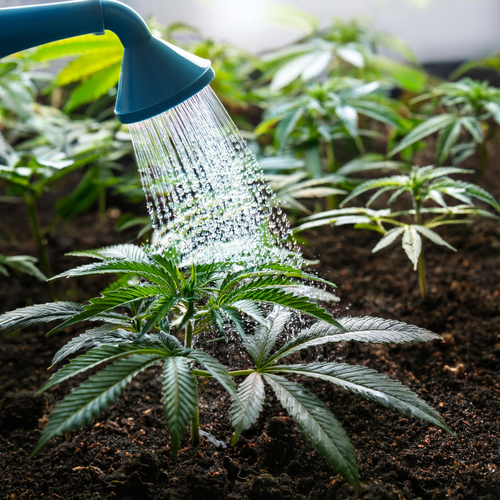
Irrigation is one of the most important aspects of growing cannabis as it has a direct impact on the growth and health of the plants. However, it is not just the amount and frequency of watering that matters, but also the quality of the water used. In this blog post, we take a look at the different types of water - distilled water, tap water and osmosis water - and explain the advantages and disadvantages they offer for growing cannabis.
1. Distilled water
Distilled water is created through an evaporation process in which water is heated to create steam, which is then condensed and collected as pure water. This process removes almost all minerals, salts and impurities from the water.
Advantages:
- Purity: Since distilled water does not contain any dissolved minerals or chemicals, there is no risk of unwanted substances accumulating in the substrate or roots.
- Control over nutrients: The plants only receive water and no additional nutrients or chemicals. This allows the grower to precisely control and dose the nutrients.
Disadvantages:
- Mineral deficiencies: Plants require certain minerals such as calcium and magnesium, which are not present in distilled water. Therefore, the grower must add these minerals to the nutrient program, which means additional effort.
- Costs and effort: The production of distilled water is complex and expensive, especially in larger quantities.
2. Tap water
Tap water is the most commonly used water in homes and garden centers. However, the quality of tap water can vary greatly from region to region as it may contain various minerals and chemical additives.
Advantages:
- Availability and affordability: Tap water is widely available and relatively inexpensive, making it the most convenient option for most growers.
- Mineral content: Tap water usually contains minerals such as calcium, magnesium and iron, which are beneficial for plant growth.
Disadvantages:
- Chlorine and other chemicals: In many areas, chlorine or chloramines are added to tap water to disinfect it. These chemicals can affect root growth and should be evaporated or removed before watering.
- Different water quality: The mineral content and quality of tap water varies by region. Too high concentrations of minerals such as sodium or sulfates can have a negative impact on soil pH and nutrient uptake.
Solution: To avoid problems with tap water, many growers recommend letting the water sit for at least 24 hours before use to allow the chlorine to evaporate, or using a special water treatment method such as filtering or decalcifying the water.
3. Osmosis water (reverse osmosis water)
Osmosis water is produced through a filtration process called reverse osmosis. In this process, water is forced through a membrane that removes almost all dissolved solids, salts and impurities.
Advantages:
- Purity and Control: RO water is virtually free of minerals and contaminants, making it a very controllable water source. It allows growers to apply precise nutrient solutions without the water containing unwanted chemicals or minerals.
- Avoiding salt or mineral overload: Since osmosis water contains virtually no minerals, the risk of over-fertilization or salt deposits in the substrate is reduced.
Disadvantages:
- Missing minerals: As with distilled water, osmosis water lacks important minerals such as calcium and magnesium. These must be added either through special fertilizers or mineral additives.
- Water treatment costs: Reverse osmosis systems are relatively expensive to purchase and operate. In addition, wastewater is generated during the filtration process, which leads to higher water consumption.
Which water is best for growing cannabis?
Choosing the right water depends on several factors, such as the water quality in your area, the growing system (soil or hydroponics) and your desired nutrient management.
- Tap water is a cost-effective and convenient solution for many growers, especially if it is of good quality. However, it may require additional measures such as removing chlorine or adjusting the pH.
- Distilled water is good for those who want to have complete control over their plants' nutrient intake. However, you have to make sure that all the necessary minerals are added manually, which increases the effort.
- Reverse osmosis water offers the advantage of high purity and control, but also requires additional minerals and nutrients to be added, which incurs additional costs and effort.
In practice, many professional cannabis growers prefer reverse osmosis water because it allows them to maintain precise control over nutrient levels and water quality. However, beginners looking for a simpler solution can start with tap water and adjust it as needed.
Conclusion
Choosing the right water for your cannabis grow depends on your growing situation and the specific needs of your plants. It is important that you check the water quality regularly and make sure that your plants are getting all the nutrients they need at the right concentration. Carefully choosing and adjusting your irrigation system can have a big impact on the success of your harvest - so take the time to find the best solution for your grow setup!
